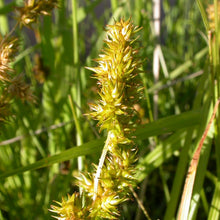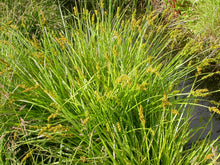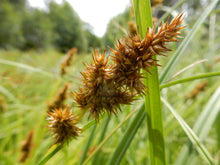Carex stipata
Sawbeak or Awl-fruit Sedge is an essential component in wetlands across much of the Pacific Northwest, where it establishes quickly to stabilize soil, host caterpillars and provide a larval food source for butterflies and moths. Its coarse leaves form dense tufts, while summer sprays of golden yellow seed heads feed songbirds and make this a prominent plant in moist, sunny landscapes.
- Plant type/canopy layer: deciduous perennial grass or grass-like
- Size at maturity: 0-3' high, 1-3' wide
- Light requirements: full sun to part sun/part shade
- Moisture requirements: moist soils, tolerates seasonal wetness
- Bloom time: April - May
- Growth rate/ease: fast growing, easy to grow
- Wildlife support: caterpillar host plant and larval food source for butterflies and moths, seeds provide food for songbirds
- Native habitat/range: grow in wet places, across much of the Pacific Northwest at elevations from 100-5700 feet. Portland Plant List - yes.
- Special features & uses: deer resistant; meadowscapes, raingardens, open woodland gardens, erosion control, bank stabilization,
Gardening with Sawbeak Sedge: This sedge will thrive in any full to part sun area with wet or boggy soils, such as a wet meadow, raingarden or moist, open woodland garden, where its sprawling rhizomes help to control erosion and stabilize banks. It tolerates seasonal flooding and requires summer water if planted in areas that become dry.
Photo Credits: "Carex stipata" by Matt Lavin is licensed under CC BY-SA 2.0






